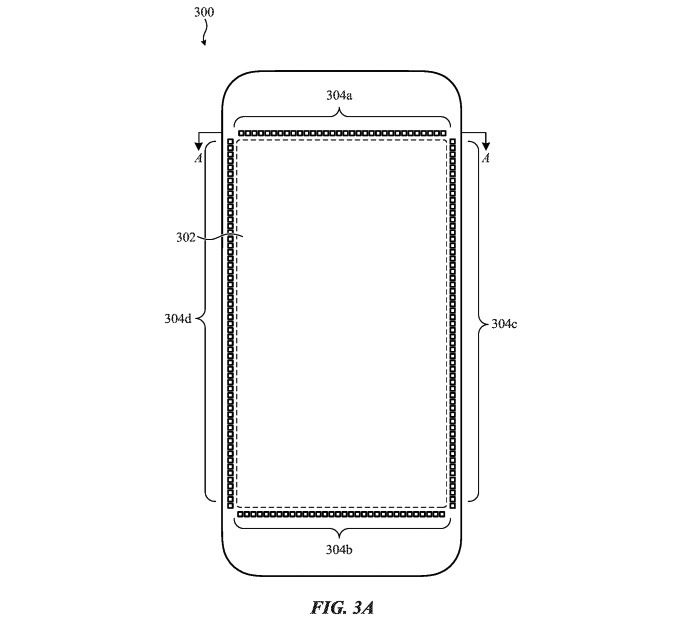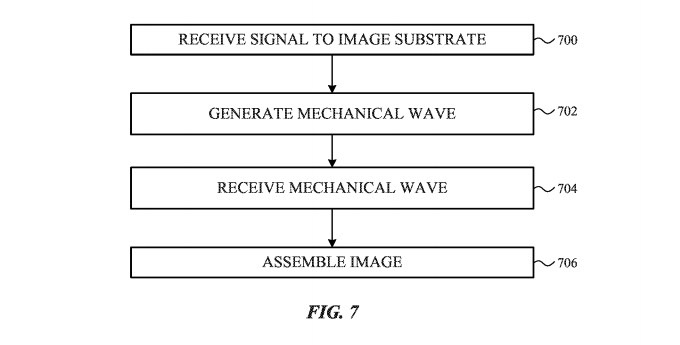Apple’s next flagship iPhone will have a bigger display-to-body ratio than any other iPhone before it, rumors indicate, as Apple is preparing for a radical design change. The iconic home button of the iPhone is going away. Or better said, the physical button is going away, but the button’s features will remain. By eliminating the home button, Apple can extend the display without increasing the size of the iPhone.
While most reports expect the iPhone 8’s new OLED screen to also incorporate a Touch ID fingerprint sensor, at least one rumor says that Touch ID is going away, and a new facial recognition system that will take its place. But a new discovery seems to indicate that Apple is very fond of fingerprint sensors, even if that means coming up with novel ways to integrate them.
A new patent application titled Acoustic Imaging System Architecture found by Apple Insider reveals that Apple is contemplating using acoustics to replace two distinct sensors that prevent it from offering an all-screen iPhone right now, with special emphasis on the fingerprint sensor.

The patent application indicates that Apple might ditch Touch ID as we know it, but it’ll do so without sacrificing the fingerprint-reading capability of the iPhone that’s a crucial element for unlocking the device, signing into apps, and making Apple Pay payments.
Instead, Apple might use an array of transducers placed around the display that can generate acoustic waves and monitor the way users interact with the screen. The sensors would not hinder the interaction with the screen, as they can be placed in areas that you wouldn’t normally touch. The system would be able to detect a foreign object, like a finger, and create a unique signature for the wave reflections caused by the ridges on a finger pad that make up the fingerprint.
Considering each fingerprint is unique, the acoustic data generated by the system would create unique signatures for each finger. The system could be used to preserve the fingerprint-based biometric security feature in a device whose front side is made up of a large display, with no room for traditional Touch ID fingerprint sensors.

These acoustic sensors could also be trained to recognize other body parts, like an ear. The phone would thus know whether the user is talking on the phone and would turn off the display during the call. That would eliminate the need for a separate proximity sensor on the iPhone, freeing up more space for the display.
Interestingly, even the drawings indicate that Apple wants to remove the home button, and the new acoustic imaging system might help out with those efforts.
While this invention is all about increasing the screen size of an iPhone display without increasing its overall footprint, and while the acoustic sensors can be placed on the edges of the display as shown in these images, the patent notes that they could also be found anywhere inside the phone.
The patent was filed last year in mid-August. Around that time, we already knew that the iPhone 7 would have a “boring” design and that Apple’s radical design changes would arrive at some point in the following years. That said, this is just a patent application for the time being, and there’s no telling whether Apple will actually make use of the technology in the upcoming iPhone 8.
However, the patent does indicate that Apple may simply change the way Touch ID works, rather than killing the security feature completely. Let’s not forget that Apple’s Touch ID tech was so good when it debuted that competitors had a hard time replicating it — the most obvious case was the Nexus 6, which shipped without a fingerprint sensor since nothing could match Apple’s. Not to mention that Apple is still advocating strong encryption-based security in its devices, iPhone included, and there’s probably no better way to secure a device than using one’s fingerprint.








